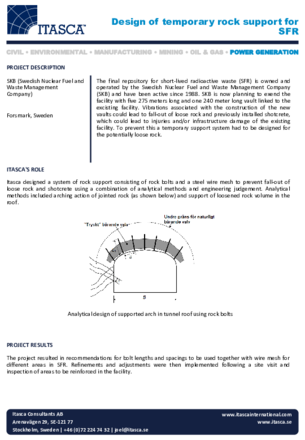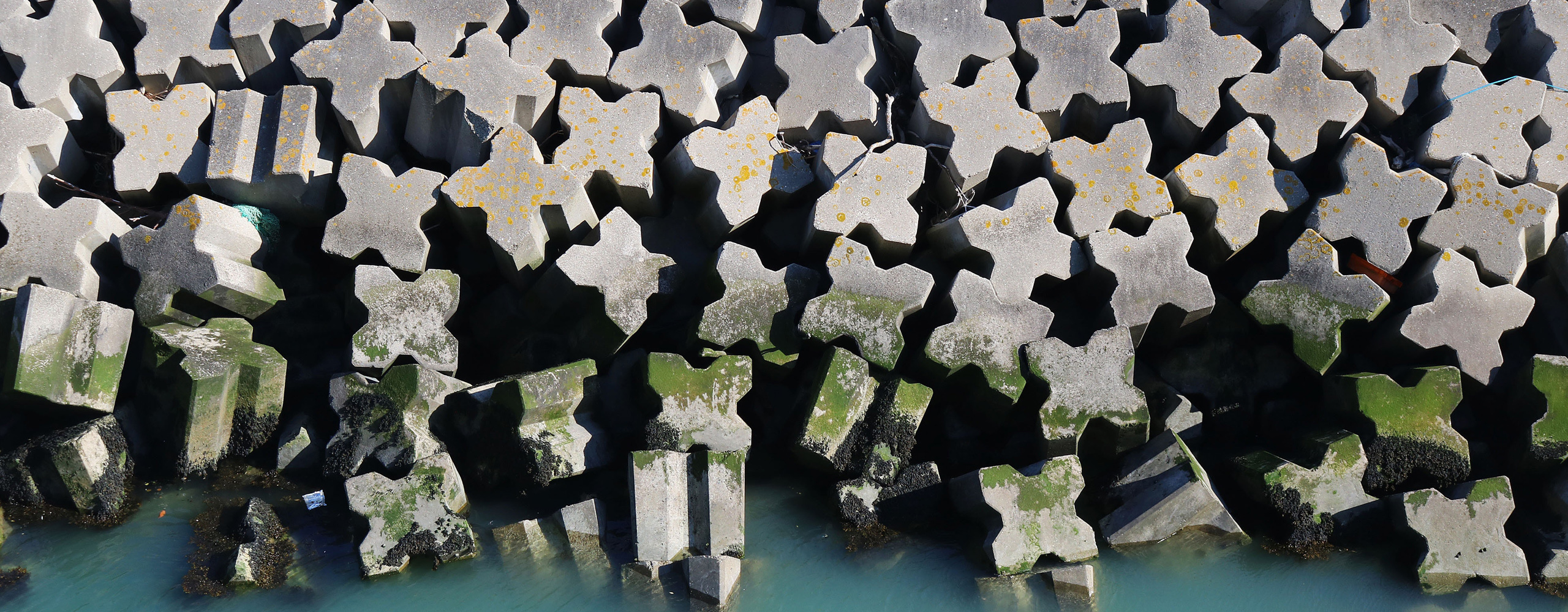
Seismicity and Modeling for the Kiirunavaara Mine kopia (2021)
LKAB’s Kiirunavaara Mine is a large, underground, sub-level caving mine that has been seismically active since approximately 2008. With this seismic activity comes associated vibrations. These vibrations can be felt on surface in the town of Kiruna, which is currently located close to the mine on the hangingwall side. The mine is undergoing a national permitting process concerning a desired increased production rate. An important question for this process is: will the increased production rate result in changes to vibrations in the town due to seismicity?

Modeling of Spalling in PFC3D — A Quantitative Assessment (2020)
SKB is interested in developing a 3D discrete model to predict spalling on the excavation boundaries of underground repositories for the long-term storage of spent nuclear fuel. This project provided a quantitative assessment of modeling spalling using PFC3D to study both lab- and tunnel-scale behavior.

Simulating Spalling With a Flat-Jointed Material (2020)
Long-term storage of spent fuel is critical to the nuclear energy industry. The Swedish Nuclear Fuel and Waste Management Company (SKB) is developing an approach for the storage of spent nuclear fuel in an underground repository in competent crystalline rock. In order to better understand the spalling damage process, an in-situ test involving the drilling of two boreholes was performed in Äspö diorite at SKB’s underground hard rock laboratory in Äspö. Tests and monitoring were performed on the pillar that separated the boreholes. In order to further investigate the damage process, Itasca performed numerical modeling using PFC3D and FLAC3D.

Seismic Performance of the OPC Puerto Cortes Container Terminal in Honduras (2019)
Itasca conducted a seismic performance evaluation of the trestle‐wharf section of the OPC Puerto Cortes Container Terminal, located in Honduras. A FLAC3D analysis of the soil is performed, including the piles and deck of the terminal. This is a fullycoupled, dynamic, soil‐structure, time‐history analysis that quantifies the performance and potential risks for the structure and slope. The Finn model – Byrne formulation was utilized using data from investigation boreholes.

Penetration of a Single Steel Foundation Pin in a Granitic Rock (2018)
The development of a subsea tidal turbine requires specific research work concerning the design of the foundation in contact with the seabed. This design stage can be simplified by the use of numerical modelling and more particularly by using discrete modelling. HydroQuest asked Cathie Associates to check their previous calculations regarding the behavior of a single steel foundation pin in a granitic rock mass by using Itasca’s discrete numerical approach and follow the forces applied to the pin as well as the state of the damaged zone around the tip during penetration.

Modelling over-boring and extension of a tunnel with surrounding excavations (2018)
As part of phase four in the extension of the ANDRA Meuse/Haute-Marne Underground Research Laboratory, a safety niche (called GT1) will be over-bored into a larger section, then extended. The tunnel axis is 16 m from an auxiliary shaft (named PX). Two perpendicular drifts, called GLN and GLE, connect these 2 excavations.

Junction Dam (2018)
Built between 1959 and 1961, Junction Dam is a double-curvature concrete arch dam located on Silver Creek in El Dorado County, California, just downstream from where Little Silver Creek and South Fork Silver Creek merge. The dam is in a relatively narrow canyon with steep sides and retains the Junction Reservoir.

Dynamic Soil Structure Interaction Analyses of North Shore Pump Station (2017)
Located near Fisherman’s Wharf in San Francisco, North Shore Pump Station is a part of the North Point Wet-Weather Facility (NPF), which provides primary treatment for disinfection of wastewater. The facility is a two-story building that is completely embedded in soil, and the subsurface conditions include potentially liquefiable sand layers and soft Bay Mud deposits sitting on bedrock sloping toward the east side waterfront. The building is supported by piers extending all the way into the Franciscan Complex bedrock.

Modelling concrete slab on rigid inclusion reinforced soil (2017)
In the context of a wine cellar extension project, a 20cm thick concrete slab is to be constructed on a soil reinforced by rigid inclusions. Itasca France has been called by the design office to verify the mechanical resistance of the concrete slab and assess its settlement under a uniform load.

Sjömalmen — Cave Modeling and Prediction of Ground Deformations (2017)
The city of Kiruna is partly located on the hanging wall side of the LKAB Kiirunavaara Mine. In the long-term perspective, it is not possible to have any residential buildings or infrastructure within the fracture zone and cave zone resulting from mining. An urban transformation process for the Kiruna city center is thus currently underway. The current prognosis is empirical based on observations since the early 1960s until today.

Rock Mechanics Study for the Kevitsa Strategy Project (2017)
The Kevitsa open pit mine has been in operation since 2012 and was acquired by Boliden in 2016. A new strategic plan is currently being developed to investigate an increase in production. In conjunction with this, the geotechnical slope design parameters for the final pit depth, including a possibly deeper pit, need to be analyzed.

Modeling and Calibration of a Blocky Granite Rock (2017)
In the framework of the development of a subsea tidal turbine, the design of the foundations has to be optimal. Cathie Associates, on behalf of HydroQuest, wanted us to investigate the penetration of a single steel foundation pin in a granitic rock mass by using a discrete numerical approach and follow the state of the damaged zone around the tip during penetration.

Practical Open Pit Rock Mechanics (2017)
Open pit mining often result in high rock slopes, sometimes combined with difficult rock conditions. This is further augmented by large blasting rounds resulting in high vibrations. Reinforcement of pit slope walls is also difficult and many times associated with high costs and loss of production. Bench slope stability is vital for a safe working place for all personnel in the mine as well as for avoiding production loss. Itasca Consultants AB is providing technical, on-site rock mechanics expertise to several open pit mines in northern Sweden.

Rock Mechanics Pre-Feasibility Studies (2017)
When starting a new mine, whether it's a open pit or an underground mine, the designer faces many challenges! One of these is the understanding of rock mass conditions and how this affects the choice of mining methods and the mine design at an early stage.

Seismic Deformation Analyses of a Hydraulic Fill Embankment Dam (2017)
As part of evaluation of seismic performance of this 175-foot high hydraulic fill dam located at a confidential site in the southeast Appalachia region, Geosyntec hired Itasca Consulting Group (Itasca) to perform deformation analyses for seismic loading of the dam using numerical modeling. Prior to the deformation analyses, Itasca also assisted Geosyntec with numerical simulations to assess the liquefaction potential of the dam using the cyclic stress ratio approach.
